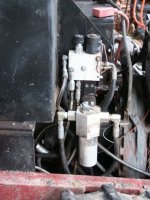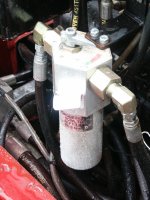Carl,
Sorry to have confused you and anyone else. The tram pump, aka VSP, aka variable volume swashplate pump, is the primary pump driving the wheel motors on the tractor. The variable volume swashplate enables stop, slow, fast, forward and reverse. As I wrote, it has lots of advantages, but tolerance of dirt particles isn't one of them.
There are other kinds of variable volume pumps for different purposes. e.g. if a standard piston pump has a spring added between the piston and the crank, the displace is reduced as the load increases, enabling a more constant load on the motor. It is often used in situations where the load is fluctuating, e.g. log splitters.
Based on comments at TBN, I think that PT may have had issues with the seals in the accumulators over the years. Your filter may have been an attempt to see if filtering would have an impact on the seal/accumulator wear.
Personally, I think that until you get all of your hoses replaced, I wouldn't dare put a flow meter in any circuit that was not directly filtered. I have had some spectacular flow meter failures when a piece of debris gets stuck. In general, I think that know what the pressure and temperature is at various points the system is probably more informative about your system health and performance.
A trick that I have used in other situations is to use a hose clamp to hold a thermocouple in good thermal contact with an item of interest, and then insulating the area with a bit of hose insulation. It doesn't make for a fast responding temperature, but it usually is pretty accurate. It often beats trying to find a 4000psi JIC-3.19.45-SN-9Q class K thermocouple hydraulic fitting...
Omega sells a variety of tthermocouple products.... Not cheap, but.. Their
CN606 will monitor six thermocouples and set an alarm when any of them are out of bounds.
All the best,
Peter

